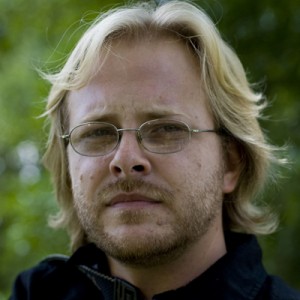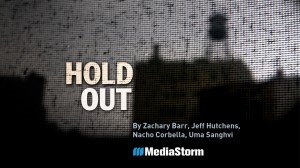Nacho Corbella is an award winning Multimedia Producer with several years of teaching experience and content gathering and editing for Multimedia, Print and Television productions. Today, he’s back in Chile teaching Multimedia Narratives, Photojournalism and Infographics in the Journalism School of Universidad de los Andes.

Could you tell me a little bit about your background with photography and multimedia production?
So I was a J student, basically. The only photo class that I had taken was an art photo class when I was an undergrad. Then I had this Multimedia project with Rich Beckman where I held a Digital SLR for the first time. That’s when I really grabbed that camera and made it mine, made her mine. I was shooting digital, it had just came out. It was the D30. I was just shooting and shooting, and editing and editing, and working with a ton of talented people. That was the best week of the class ever. A full week of getting constant feedback. That’s my photographic background basically. I just grabbed a camera for a whole week and just shot-shot-shot. I never left it.
You produced a very moving piece titled, “Life After Foreclosure.” Could you walk us through your thought process while you were making that piece? What were your goals going and and what did you do to reach those goals?
I’m going to tell you how long it took me first. It was part of my thesis. I had a whole year basically to work on my thesis from my pre-production to shooting and everything. So I had this plan in mind, I was going to do this simple story thesis topic. Then the recession happened in 2007 and the whole market crashed. I watched TV, I would read the newspapers, I would read the magazines, and I wouldn’t see anyone… anyone. They were all just numbers. There were no people. I wanted to put a face on the crisis.
I think I have 700 emails that were sent in conversations trying to get people anywhere in the US. Constant phone calls, going to churches, going to foundations, going to whatever. Nothing would happen. Imagine every week how shitty you can feel when you try over and over to get somewhere. After almost six months I said, “Okay, if I don’t get anything by this Monday I’m done.” So Thursday afternoon I get this phone call from a friend telling me that there was this person that lives in Charlotte that was willing to talk and I was like, “Wow. Phone number? Name? Done. Thank you so much.” Hung up. Grabbed the phone. Lit up a cigarette and said, “Here it goes.” Called Cynthia, “Hi this is Nacho…” Same speech I always begin with. And she starts telling me her whole story. It was perfectly perfect. She was telling me the whole story and everything I needed. After 5 minutes she keeps telling me and she starts crying and I’m like, “Shit, okay Cynthia. I’m really interested in your story. I’d love to meet you in person, if I can record an interview it would be great.” And she was like, “I would love to share this with you.”
Next morning I put everything in the car, drive all the way to Charlotte, three and a half hours, get there, opens the door… I’m in. I sit in, shoot the interview, we talk a little bit, shoot the interview. I go to a hotel and start transcribing my ideas, thinking about structure, all on the fly.
You have this preconceived idea, I had 3 and a half hours to think about it, but then when you get there… it’s their story not yours. The next morning I go back to Cynthia and knock on the door. 8am. She opens the door wearing her pajamas. And that’s it. That’s when you know you’re in. When the person you’re interviewing opens their door to you without caring that you’re going to be shooting with a camera and their hair is messed up, you know you’re in. Now I’m the only one that can fuck this up. So it’s all on me, and that’s the most beautiful feeling when you’re shooting a story. Because you know everything is there, you just need to do your job and do it well so you can actually portray what that person is sharing with you.
I can still remember she opened the door, pajamas, “come in.” That’s it! That’s how I shaped that story.
How do you combine still photography and video to create a compelling narrative?
I’m going to quote MediaStorm here. You know how to do it. You know video is good for motion and you know stills are good for moments. And you know at the same time that you’re just one person. And if you want to do a real good job you have to focus on one or the other.
It’s a constant battle. I know what I need is going to happen there and I’m always going to be carrying my camera, super light, I’ll be ready at 2.8. I don’t care about situation, I’ll just change the ISO. Go in and you can always have a small recorder on hand if you want to record something small.
You choose your battles. I’m going to go all-in with the video camera, I’m going to be a very ninja-tactical person with my photo camera and I’m going to pull it out whenever I need. You start balancing it. One of the best things that I could have done is put a camera strap on my video camera so I can have video camera on my right shoulder, still camera on my left shoulder, so whenever something happens I can shoot.
You attended our 2009 Advanced Multimedia Workshop and helped produce the piece “Hold Out.” What were the biggest takeaway points from that workshop for you?

It’s just teamwork, that’s it. Teamwork. You know you can do it all. I know I’m not a great photographer, I’m not a great videographer, I’m not a great designer or anything. But I can put a story together well. And I know I could have done that story, but not at that angle at all. I had a kick-ass photographer, I had a kick-ass reporter. We had the people, which is the most important thing. It doesn’t matter how expensive your gear is, it’s just about the team.
What motivates you to teach journalism and multimedia classes?
It’s something you love, you know? You want to share it. You want people to experience that. I want my students to experience the sensation I had when Cynthia opened that door wearing her pajamas. I want them to know that. I want them to open their eyes to the rest of the world. So teaching is just that. It’s like stepping point for them to open their eyes.
For students that are just getting into multimedia work, what is a consistent bad habit that is important to get past?
Technically: Use a frickin tripod for shooting. Also on the technical side, use a microphone.
Don’t get stuck on the technical either. Don’t forget, it’s not your story, it’s their story, and you’re just helping them tell that story. You can plan your shoots which will help you on the field if you’re not very comfortable, you can plan your questions which will help you a ton during the interview, but just don’t be like a horse race. You need to be looking around you. It’s not just about the technical, it’s not just about the questions, it’s about what’s the best way to tell this story.
What about bad habits on the storytelling side?
Your audience is going to be sitting in front of the computer having their meal, and your story is their meal. You need to sharpen those knives. Out of that big fat greasy piece of meat you need to make fillet. And that’s what you’re going to feed your audience, you’re going to feed them fillet. Take out all the stuff that is not necessary to tell that story in just a couple of minutes.
What issues do you see in the professional community?
We just get too structured. We keep pushing the same thing over and over. And that’s great because we know it works. But you need to be a tourist in your own town. We’re loosing that surprise or amaze factor. Lazy, that’s the worst problem. I don’t care regardless of age, if you get lazy, you’re done.
Do you think the solution is inspiration? Is energy the issue?
I don’t know if it’s an energy issue or not. I don’t know what the problem is, it’s just… you get stuck. You’re doing the same thing over and over again. And the minute you let something turn into a routine it’s something you do not enjoy.
I will buy little pieces of gear. I bought a suction cup, just for one little piece, “Roping the Wind.” In the jeep scene I put a suction cup on the tripod head. Those are little things that are going to make your story advance a little bit. You’ll feel like a kid again. And that’s key. I’m a big gadget fan, so for me it’s little things like a new wide angle lens, or this microphone, or this suction cup. That keeps me motivated when I shoot a new story.
Anything else?
Whenever you find that little thing, that little thing you love you just go balls to the wall for it. And that’s what multimedia is, you’re just telling their story, you’re touching peoples hearts. Whenever you’re showing someone a story you did and you see emotion in their face, that’s it. If you see a smile, if you see a tear, if you see someone sad, that’s it. That story fulfilled something.
Nacho’s Website: http://nachocorbella.com/
